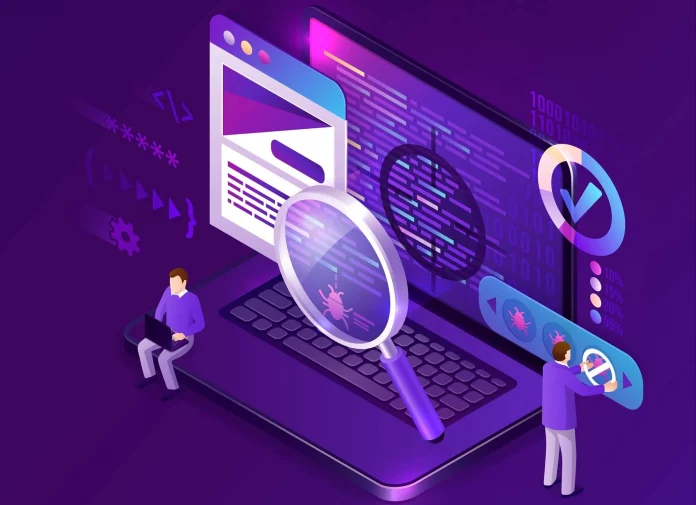The Software Development Lifecycle (SDLC) is a systematic process. Additionally, software development teams use the Software Development Lifecycle (SDLC) as a systematic process to design, develop, deploy, and maintain software applications.
Typically, SDLC consists of a series of phases or stages that guide the development process from inception to deployment and beyond.
By following this structured approach, organizations can ensure that they execute software projects efficiently and effectively while meeting the specified requirements and quality standards. These phases may vary depending on the chosen methodology.
For instance, the Waterfall model, Agile methodologies (e.g., Scrum, Kanban), or DevOps practices can influence the specific sequence of phases. Furthermore, each phase has its own objectives, deliverables, and activities.
Importance of Software Development Lifecycle
The software development lifecycle plays a crucial role in software development for several reasons:
1. Requirement Understanding
SDLC helps in clearly defining and documenting the software requirements, ensuring that all stakeholders have a shared understanding of the project goals and objectives.
2. Process Efficiency
SDLC, furthermore, provides a structured framework that improves the efficiency of software development processes. Additionally, it ensures that activities are performed in a logical sequence and that dependencies and interdependencies are identified and managed effectively.
3. Risk Management
SDLC includes mechanisms for identifying, assessing, and managing risks associated with the software development process. Moreover, by addressing potential risks early on, SDLC helps minimize project failures and costly rework.
4. Quality Assurance
SDLC incorporates quality assurance activities at each phase, such as testing and code reviews, to ensure that the software meets the desired quality standards and functional requirements.
5. Collaboration and Communication
SDLC promotes effective collaboration and communication among development teams, stakeholders, and clients. Furthermore, it provides a common language and understanding of the development process, facilitating smoother interactions and feedback loops.
Software Development Lifecycle Phases
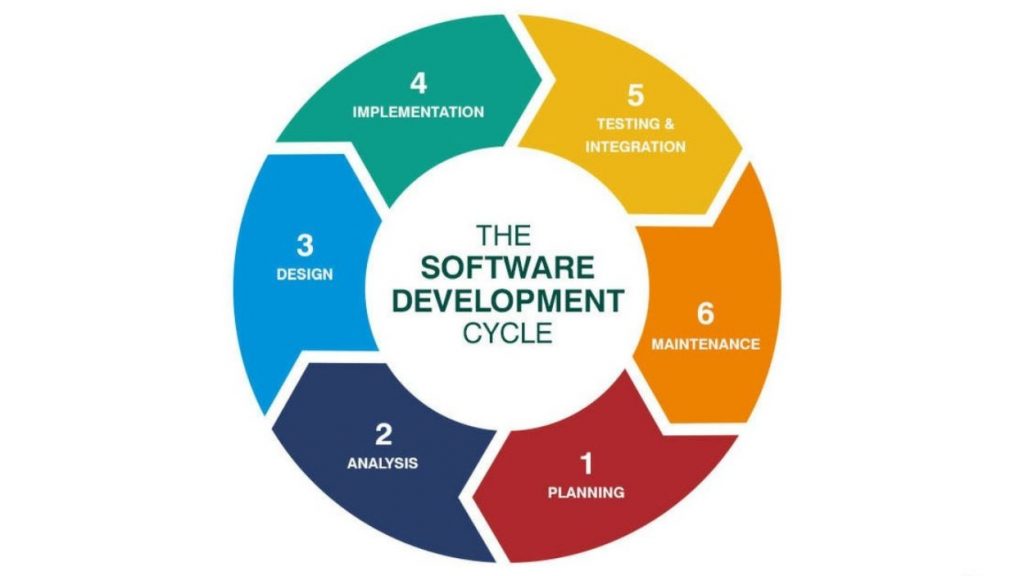
1. Requirements Gathering and Analysis
In this phase, the requirements for the software project are collected, analyzed, and documented. First, the goal is to understand the needs of the stakeholders, including end-users, and translate them into clear and actionable requirements.
This involves gathering information through interviews, workshops, and documentation reviews. Once the initial information is gathered, the requirements are then analyzed for feasibility, consistency, and completeness.
2. System Design and Architecture
In this phase, the high-level system design and architecture are defined based on the requirements gathered in the previous phase.
Firstly, the system design includes the overall structure, components, interfaces, and data flow of the software. Additionally, architectural patterns and frameworks are chosen, and system dependencies are identified.
3. Coding and Implementation
In this phase, the software solution is developed based on the design specifications. Additionally, developers write the code, following coding standards and best practices.
During the implementation phase, several steps are taken, such as converting the design into executable code, integrating components, and implementing functionality according to the requirements.
Start your journey toward successful digital product development today! Contact us to discuss your ideas, explore innovative solutions, and transform your vision into a reality.
4. Testing and Quality Assurance
In this phase, the software is rigorously tested to ensure it meets the specified requirements and functions as intended.
Moreover, testing is performed at various levels, including unit testing, integration testing, system testing, and acceptance testing. Additionally, quality assurance activities focus on identifying and resolving defects, improving code quality, and verifying compliance with standards and guidelines.
5. Deployment and Release Management
In this phase, the software is prepared for deployment to the production environment. Firstly, this involves packaging the software. Next, configuring the deployment environment is carried out. Additionally, the necessary steps are performed to make it available to end-users.
Moreover, release management activities focus on planning, coordinating, and controlling software releases. Ultimately, these activities ensure a smooth transition to the live environment.
6. Maintenance and Support
In this phase, the software is deployed and made available to end-users. Subsequently, maintenance and support activities come into play, focusing on monitoring the software’s performance, addressing any issues or bugs that arise, and providing ongoing support to users.
Furthermore, this phase involves regular updates, bug fixes, enhancements, and user assistance.
Explore the Software Development Lifecycle Methodologies
1. Waterfall Model
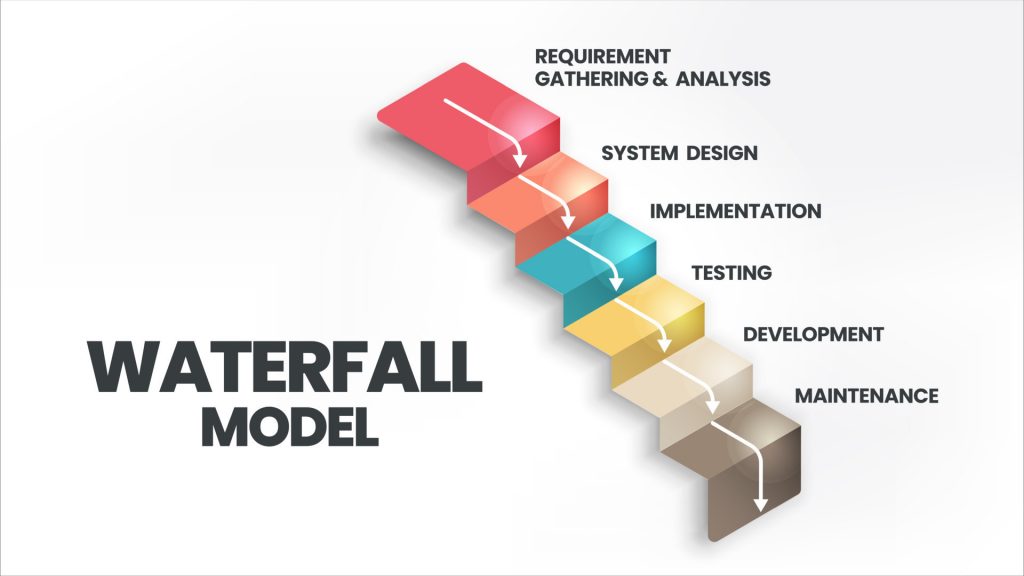
Phases of the Waterfall Model
The Waterfall model is a traditional, linear approach to software development. Moreover, it consists of distinct phases that are executed sequentially, with each phase building upon the outputs of the previous one. Additionally, the typical phases of the Waterfall model include:
A. Requirements Gathering: In this phase, project requirements are collected from stakeholders, analyzed, and documented. This phase aims to establish a clear understanding of what the software should accomplish.
B. System Design: Based on the requirements, the system design phase involves creating a detailed design that outlines the architecture, components, interfaces, and data structures of the software system.
C. Implementation: In this phase, the actual coding and programming take place. Developers write code according to the design specifications, and individual modules or components are developed.
Discover the insights and techniques on how to build software from scratch. Read our article now for a step-by-step guide and expert advice.
D. Testing: The testing phase involves conducting various tests to identify defects, bugs, or deviations from the requirements. It includes unit testing, integration testing, system testing, and user acceptance testing.
E. Deployment: Once the software has been thoroughly tested and approved, it is deployed to the production environment. This phase includes activities like installation, configuration, and data migration.
F. Maintenance: After deployment, the software enters the maintenance phase. This involves addressing bug fixes, enhancements, and updates based on user feedback, ensuring the software remains functional and up-to-date.
Advantages of the Waterfall Model
- Clear and well-defined requirements: The sequential nature of the Waterfall model allows for upfront requirement gathering and documentation, reducing ambiguity and improving project planning.
- Easy to understand and manage: The linear structure of the model makes it easier to manage and track project progress, as each phase has distinct deliverables and milestones.
- Well-suited for small, well-understood projects: The Waterfall model is often used for small projects with fixed requirements, where changes are minimal and well-understood.
Disadvantages of the Waterfall Model
- Lack of flexibility: The linear nature of the Waterfall model makes it difficult to accommodate changes or evolving requirements once a phase is completed, potentially leading to costly rework.
- Late detection of defects: Since testing occurs towards the end of the development cycle, defects or issues might only be identified late in the process, making them more challenging and expensive to rectify.
- Limited stakeholder involvement: Stakeholder involvement is typically limited to the requirements-gathering phase, potentially resulting in reduced collaboration and less frequent feedback.
Use Cases and Applicability
The Waterfall model is well-suited for projects with the following characteristics:
- Clear and stable requirements: When the requirements are well-defined, stable, and unlikely to change significantly during development, the Waterfall model provides a structured approach to delivering the desired software.
- Small-scale projects: The Waterfall model can be effective for small projects with straightforward requirements, where the development team has a good understanding of the technology and domain.
- Projects with strict regulatory or contractual requirements: In situations where adherence to specific regulations or contractual obligations is critical, the Waterfall model’s rigorous documentation and traceability can be advantageous.
2. Agile Methodology
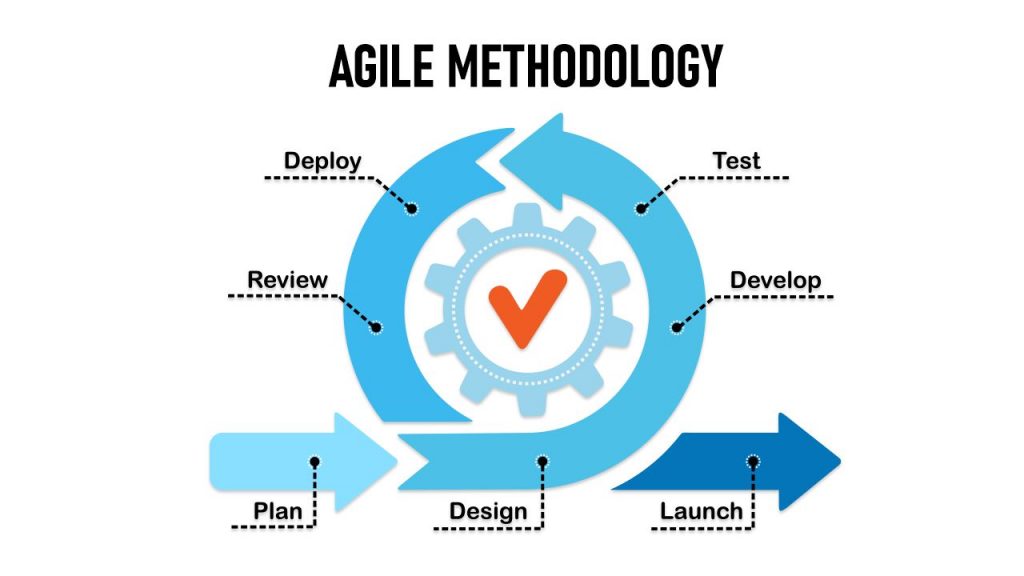
Principles and Values of Agile
Agile is an iterative and incremental approach to software development that focuses on delivering value to customers through adaptive planning, collaboration, and continuous improvement. It is guided by a set of principles and values outlined in the Agile Manifesto, including:
A. Individuals and interactions over processes and tools: Agile emphasizes the importance of effective communication, collaboration, and trust among team members, recognizing that people and their interactions are crucial for project success.
B. Working software over comprehensive documentation: Agile prioritizes delivering functional software that meets the needs of users over excessive documentation. While documentation is still important, the emphasis is on tangible outcomes.
C. Customer collaboration over contract negotiation: Agile promotes the active involvement of customers and stakeholders throughout the development process, fostering collaboration, gathering feedback, and adapting to changing requirements.
D. Responding to change over following a plan: Agile embraces change as a natural part of software development. It encourages teams to be flexible, adaptive, and responsive to customer needs, allowing for iterative and incremental improvements.
Agile Frameworks
Agile methodologies are typically implemented using specific frameworks that provide a structure for project management and development. Some popular Agile frameworks include:
A. Scrum: Scrum is an iterative framework that divides the development process into time-boxed iterations called sprints. It emphasizes collaboration, self-organization, and continuous improvement. Scrum teams work in short cycles, delivering working software at the end of each sprint.
B. Kanban: Kanban is a visual framework that focuses on continuous flow and work-in-progress (WIP) limits. It visualizes the workflow, allowing teams to monitor and optimize their work processes. Kanban provides transparency, flexibility, and a pull-based system for managing tasks.
C. Lean: Lean is an Agile methodology derived from Lean manufacturing principles. It aims to eliminate waste, optimize processes, and deliver value to customers efficiently. Lean promotes continuous improvement, customer focus, and a culture of problem-solving.
D. Extreme Programming (XP): XP is an Agile framework that emphasizes close collaboration, fast feedback, and technical excellence. It includes practices like pair programming, test-driven development, continuous integration, and frequent releases.
Benefits of Agile
Agile methodologies offer several benefits that contribute to improved software development outcomes:
A. Flexibility and Adaptability: Agile allows for frequent changes and adaptations to project requirements, enabling teams to respond quickly to customer needs and market dynamics.
B. Customer Satisfaction: Agile methodologies emphasize customer collaboration and feedback, ensuring that the delivered software meets customer expectations and delivers value.
C. Faster Time to Market: The iterative and incremental nature of Agile allows for early and frequent delivery of working software, accelerating time to market and enabling faster feedback loops.
D. Improved Quality: Agile practices, such as continuous integration, automated testing, and regular inspections, promote higher-quality software through early defect detection and continuous improvement.
E. Team Collaboration and Empowerment: Agile fosters collaborative teamwork, self-organization, and shared responsibility, empowering team members to make decisions and take ownership of their work.
Challenges of Agile
A. Cultural Change: Adopting Agile requires a cultural shift within an organization, as it necessitates changes in mindset, roles, and team dynamics. Furthermore, Resistance to change can be a challenge that needs to be managed effectively.
B. Skill and Knowledge Requirements: Agile methodologies require teams to possess the necessary skills and knowledge to implement Agile practices effectively. Additionally, Training and coaching may be necessary to ensure successful adoption.
C. Scalability: Scaling Agile practices to larger projects or distributed teams can be challenging. Additional frameworks or approaches, such as SAFe (Scaled Agile Framework) or LeSS (Large-Scale Scrum), may be needed for effective scaling.
D. Balancing Documentation: Agile focuses on delivering working software over comprehensive documentation. However, striking the right balance between documentation and agility can be a challenge, especially in regulated industries.
3. Iterative and Incremental Development
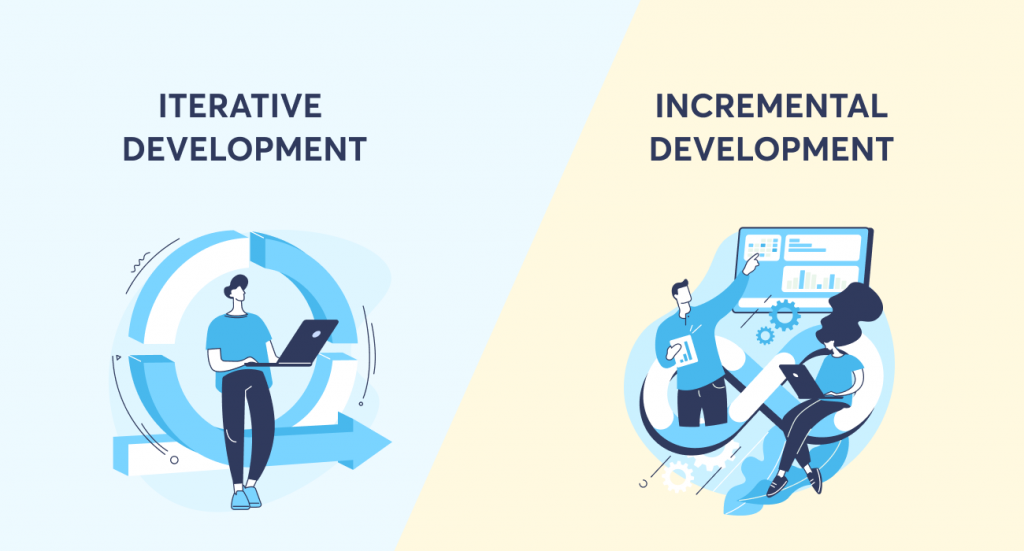
Understanding Iterative Development
Iterative development is an approach in software development where the development process is divided into a series of iterations or cycles.
Consequently, each iteration involves executing a complete software development lifecycle, including planning, analysis, design, implementation, testing, and deployment. However, the key distinction lies in the fact that the focus of each iteration is on a subset of the overall system functionality.
During each iteration, the team works on a small portion of the software, producing a working and potentially shippable increment.
Additionally, the team gathers feedback and incorporates it into subsequent iterations to refine and improve the software. Moreover, this iterative process allows for continuous learning, adaptation, and optimization throughout the development lifecycle.
Understanding Incremental Development
Incremental development is a related approach that focuses on delivering software in successive increments or releases. Moreover, each increment builds upon the previous one, adding new functionality or features.
Unlike iterative development, incremental development emphasizes delivering usable increments of the software to users or customers. In incremental development, each increment represents a complete and functional subset of the overall system.
Furthermore, this approach allows for the early release of usable software, providing value to users and stakeholders. Moreover, it enables feedback and validation to be gathered early in the development process.
Therefore, even before the entire system is completed, incremental development delivers tangible benefits and value.
Comparison Table of Iterative and Incremental Development
| Iterative Development | Incremental Development | |
| Focus | Refining and improving the software through continuous learning and adaptation. | Delivering usable increments of the software to users or customers, providing early value realization. |
| Feedback | Continuous feedback and learning throughout the development process. | Early feedback and validation with each increment. |
| Risk Mitigation | Early identification and mitigation of risks through smaller portions of the system at a time. | Identifying and addressing risks incrementally, reducing complexity and risk associated with developing the entire system at once. |
| Customer Value | Value is realized through continuous improvement and adaptation. | Early value realization and benefits to users or customers even before the entire system is completed. |
| Stakeholder Involvement | Stakeholders are actively involved throughout the development process, fostering collaboration and frequent feedback. | Stakeholders engaged in validating and providing feedback on each increment. |
| Scope and Complexity | Breaking down development into smaller, manageable iterations. | Breaking down development into successive functional increments. |
| Adaptability to Change | Highly adaptable to changing requirements and evolving needs. | Accommodates changes and adjustments with each increment. |
Examples of Frameworks | Scrum, Kanban, Extreme Programming (XP). | Agile Release Train (ART) in SAFe (Scaled Agile Framework). |
4. DevOps and Continuous Integration/Continuous Deployment (CI/CD)

DevOps is a set of practices that combines software development (Dev) and IT operations (Ops) to enable organizations to deliver software faster and more reliably.
Additionally, it emphasizes collaboration, communication, and automation to streamline the software development and delivery processes.
Moreover, DevOps aims to break down silos between development and operations teams, enabling them to work together seamlessly throughout the software lifecycle.
Key principles of DevOps include
A. Continuous Integration: Developers integrate their code changes frequently into a shared repository. This allows for the early detection of integration issues and promotes a culture of collaboration.
B. Continuous Delivery: Software is continuously built, tested, and prepared for deployment. Continuous Delivery ensures that the software is in a deployable state at any time, reducing the time and effort required for release.
C. Continuous Deployment: Once the software passes all tests and quality checks, it is automatically deployed to production environments. Continuous Deployment reduces manual intervention and enables fast and frequent releases.
D. Infrastructure as Code: Infrastructure provisioning and configuration are automated using code, enabling infrastructure to be treated as a versioned and manageable component of the software delivery process.
E. Monitoring and Feedback: Continuous monitoring of applications and infrastructure provides valuable feedback on performance, stability, and user experience. This feedback loop helps drive continuous improvement.
CI/CD Pipeline and Its Best Practices
Continuous Integration/Continuous Deployment (CI/CD) is a key aspect of DevOps that focuses on automating the software delivery pipeline.
Furthermore, A CI/CD pipeline consists of a series of automated steps that include building, testing, deploying, and monitoring software applications. Here are some common practices and components of a CI/CD pipeline include:
A. Source Code Management: Version control systems like Git are used to manage and track changes to the source code. Branching and merging strategies are employed to support parallel development and code collaboration.
B. Automated Build and Test: Code changes trigger an automated build process, where the code is compiled, dependencies are resolved, and unit tests are executed to ensure the code functions as intended.
C. Automated Testing: Various types of tests, such as unit tests, integration tests, and acceptance tests, are automated to verify the functionality, performance, and reliability of the software.
D. Artifact Repository: A central repository stores built artifacts, such as executable files or deployment packages, for versioning, tracking, and reuse.
E. Deployment Automation: Once the code passes all tests, it automatically deploys to the target environment, whether it is development, staging, or production. Additionally, automated infrastructure provisioning and configuration take place.
F. Continous Monitoring: The deployed applications and infrastructure utilize real-time monitoring tools to collect and analyze data. This helps detect issues, performance bottlenecks, and user experience problems.
Benefits of DevOps and CI/CD
DevOps and CI/CD offer several benefits to organizations:
A. Faster Time to Market: By automating and streamlining the software delivery pipeline, DevOps and CI/CD enable organizations to release software faster, reducing time-to-market and gaining a competitive advantage.
B. Improved Quality: In the development process, continuous testing and feedback loops ensure that teams identify and address issues early. This leads to higher-quality software with fewer defects.
C. Enhanced Collaboration: DevOps promotes collaboration and communication between development and operations teams, breaking down silos and fostering a culture of shared responsibility.
D. Increased Efficiency: Automation of manual processes reduces human errors, eliminates repetitive tasks, and improves overall efficiency in software development and deployment.
E. Scalability and Resilience: With automated infrastructure provisioning and deployment, organizations can easily scale their applications and handle increased traffic or workloads. Resilient systems can quickly recover from failures, reducing downtime.
F. Continuous Improvement: DevOps and CI/CD encourage a culture of continuous improvement, where teams continuously learn, adapt, and optimize their processes, leading to ongoing enhancements in software delivery.
Conclusion
Understanding the Software Development Lifecycle (SDLC) is crucial for software professionals and organizations involved in developing and delivering software solutions.
Moreover, The SDLC provides a structured and systematic approach to software development, ensuring that projects are well-planned, executed, and maintained.
A thorough understanding of the SDLC and its various components empowers software professionals to navigate the complexities of software development projects with confidence.
Moreover, by embracing the principles and practices of the SDLC, organizations can deliver high-quality software solutions that meet customer needs, drive innovation, and ensure long-term success in the dynamic world of software development.

